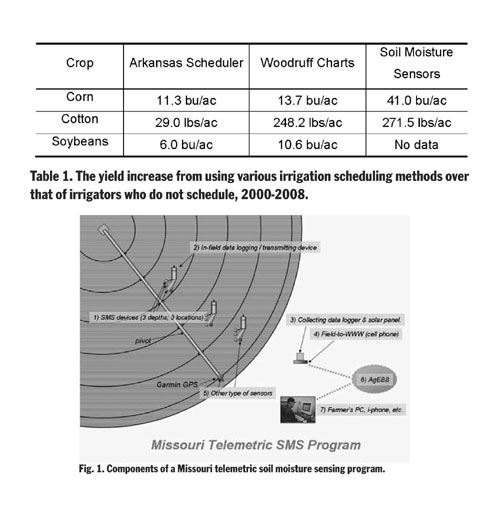Soil Moisture Sensing Via Telemetry
Center pivot irrigation accounts for 40% of all irrigated acreage in Missouri. There are approximately 4,000 pivots in the state, most in the Bootheel. It is estimated that yields on center pivots could be increased 10-15% if better irrigation management, specifically irrigation scheduling, were used. One viable scheduling method is the use of soil moisture sensing (SMS) devices, however, for a host of reasons Missouri farmers are not using SMS. Missouri irrigators would probably increase the use of SMS technology if SMS data could be automatically collected and made available to them at a reasonable price. Telemetric SMS systems are being tested at the Delta Center.
Irrigators in Missouri who do use irrigation scheduling out-yield their counterparts who do not schedule. Although use of soil moisture sensors was only reported by 1% of corn growers and 1% of cotton growers, the results from this small sample were outstanding. Table 1 shows the increased amount of yield enjoyed by irrigators who employ the Arkansas Scheduler computer program, the Woodruff charts, or soil moisture sensing devices over their counterparts who do not schedule their irrigation.
To properly use SMS on center pivots at least three locations should be monitored to account for distribution differences in the pivot. It is recommended that each location have a 6-, 12-, and an 18-inch sensor. Two types of sensors seem to be feasible due to their cost, ease of use, and reliability. These are WaterMarks and small capacitance sensors. It is desired that no wires be strung out in the field, so all communication of data is done telemetrically.
Sensors are installed at the beginning of the season after the crop has first emerged. Readings from the sensors are sent telemetrically to either the farmer’s own PC via repeaters or to a website via cell phone modem. The University is exploring developing a hosting site at its AgEBB website. Figure 1 shows the components of a SMS monitoring system hosted at the university.

The initial investment cost varies on company used and whether the system sends data to your PC or to the web. A reliable system can be set up for $3,000. The annual per-acre cost of this setup would only be about $5.07 per acre for the PC system or $6.79 per acre for the web-based system. These costs would decrease if a farmer has two or more pivots next to each other.
If one compares those costs to the yield increases farmers experience through irrigation scheduling, it appears that this investment could well pay for itself time and time again. Δ
DR. JOE HENGGELER: Ext. Assc. Prof., Biol. & Agric. Eng. Dept., Commercial Ag. Program, University of Missouri